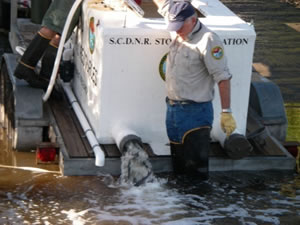Influence of Stocking on Striped Bass Populations
In the Carolinas, striped bass, Morone saxatilis, are found in all major river drainages and generally remain in rivers year-round as compared to more northerly populations which spend a large part of their life in the sea. South Carolina’s striped bass populations began to decline in the 1970s and the State began to stock rivers in 1984 to enhance their population numbers. At the time, it was assumed striped bass in South Carolina represented a single genetic population (maintained by low levels of coastal movement) and the State stocked juvenile bass reared from Santee-Cooper parents into all systems in need of enhancement. Managers in South Carolina began to suspect that populations actually represented different stocks by the mid-1990s and stopped the practice of stocking Santee-Cooper offspring into other watersheds. Since the Santee-Cooper system experiences high levels of recreational fishing pressure, stocking to support the population has continued (fig. 1).

Even if fish are stocked into their own system, it is preferable to capture a large number of new broodstock from the wild every year as opposed to maintaining the same broodstock and their offspring over multiple years. The longer fish are held in captivity, the greater the risk of artificial selection in individuals who survive captivity, which may negatively affect survivability in the wild. Additionally, if too few broodstock are used there will not be much diversity in the system since most fish will belong to just a few parents. Genetic diversity (i.e., genetic health) can be thought of as a toolbox a population has— the more tools in the toolbox the more problems a repairman can fix; similarly, the higher the diversity of a population the more stressors or problems the population can withstand (such as higher summer temperatures the state is experiencing). South Carolina managers use a large number of wild-caught broodstock every year and no longer stock across systems. Having evaluated the current genetic health and identified the unique genetic populations of striped bass throughout South Carolina, we were curious if either of these characteristics has changed during the past two decades of stocking. We used the same set of markers that are used for genetic tagging in striped bass and compared our current data sets with archived samples from the early 1990s.
Similar to what we found in the current samples, during the early 1990s the Santee-Cooper System also contained one genetic population of striped bass from the Congaree/Wateree Rivers to the Atlantic Ocean, indicating that fish, both stocked and wild, move freely throughout the system. We also documented a small increase in the genetic health of the population from the early ‘90s to the present, indicating the number of broodstock used by managers (~100 per year) is appropriate. Therefore, not only has the long-term stocking within the Santee-Cooper System not hurt the population, it has actually resulted in improved genetic health of the striped bass population, potentially making them more resilient to stressors.
Also similar to what was documented for current samples, the ACE Basin and Santee-Cooper System were genetically distinct populations during the early 1990s, although this difference is currently less than it used to be as a result of a federal hatchery having a large number of offspring from Santee-Cooper broodstock escape into the Edisto River. North Carolina, which has only recently ceased cross-stocking broodstock among its river systems, has Roanoke strain offspring making up the entirety of the field-collected samples in the Neuse River. Additionally, Cape Fear River broodstock were identified as direct descendents of fish stocked from the Roanoke River indicating the large stocked population that makes up the majority of fish in the Cape Fear River are second generation Roanoke River stock. Given the observed genetic difference that occur between river systems in South Carolina over a long time period, and the lack of any current river differences in North Carolina, it is reasonable to infer that had South Carolina managers continued cross-stocking South Carolina rivers with Santee-Cooper strain striped bass, striped bass in the South Carolina may have lost their distinctness across populations that is still maintained today.
Our evaluation of the genetic characterization of striped bass populations over a period of stocking activity has provided evidence that the stocking practices of South Carolina is a responsible approach management strategy and the State engaged in these practices soon enough to prevent the loss of both the genetic uniqueness and health of striped bass across the State. Additionally, by using a large number of broodstock captured throughout the Santee-Cooper System, the State has not only maintained the genetic health of striped bass, but also their resilience to stressors.



